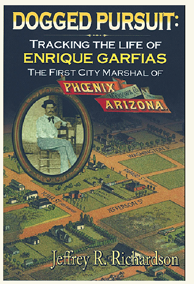|
Dogged Pursuit: Tracking the Life of Enrique Garfias, the First Marshal of Phoenix, Maricopa County, Arizona, by Jeffrey R. Richardson moves between a biography of Enrique Garfias, lawman, journalist, rancher, miner and family man, and a glimpse of Phoenix, Arizona in its beginning days. It also is a portrait of the real influence of Hispanic settlers in the Southwestern US.
Garfias was born into a respected Hispanic family living in the Los Angeles area of California, around 1849. By the time he reached adulthood, Garfias had moved east to the Arizona territory. He eventually became interested in law enforcement. According to one of several lengthy biographical notices published upon his death in 1896: “Although small in stature he was a giant in strength and knew no such word as fear… Arizona has many brave men, but for cool determined nerve, coupled with a modest unassuming manner, Henry Garfias stood at the head.” A summary of Richardson’s biography provided by the publisher states that Garfias “was one of the most notable law enforcement figures in Arizona’s territorial era. As Phoenix City marshal, constable, US deputy marshal and Maricopa County deputy sheriff, he was known as a crack shot and a tenacious man hunter. “Dedicated to the rule of law and proud of his Hispanic origins, Garfias was widely respected for his evenhanded approach to policing a frontier town sometimes beset by racial tensions. This engaging biography confirms Garfias’ prominent place in the annals of the American Southwest.” As part of full faith disclosure: I have known the author, Jeffrey Richardson, for some twenty-five years in Alaska. During that period, I have known Richardson as a journalist, an advocate for immigrant rights, and a “dogged” researcher. Richardson’s approach to writing the story of Henry Garfias entailed thorough and meticulous reading of newspaper accounts from the day, along with official and legal documents such as arrest warrants, indictments, coroner reports. What comes to light over and over, especially from the newspaper accounts of crimes and criminal events from the 1870’s through the 1890’s, is how respected and appreciated Henry Garfias was by the local press and the citizenry of the new town of Phoenix. Richardson has done an excellent job of piecing together the highs and lows of Garfias life and career in Phoenix and the surrounding area. Garfias had a strong sense of moral values and knew the best way to live that moral life was to become a Public Servant. Henry Garfias purposely lived his life largely in public view. He wanted to set an example to all the citizens of Phoenix. And he did just that. If you enjoy reading history of the American West and are interested in learning what part the Hispanic population played in that history, particularly the stories about the first settlers, the cowboys and farmers and miners, this book will provide you hours of good reading. |
